Biology MCQs with answers for NEET Strategies For Enhancement In Food Production Miscellaneous
Question 1. Which of the following group of insects is beneficial to man?
- Honeybee, lac insect, cochineal insect
- Silkworm, honeybee, wasp
- Honeybees, silkworms, cockroaches
- Sandfly, butterfly, honeybee
Answer: 1. Honeybee, lac insect, cochineal insect
- Cochineal insect produces carminic acid from which carmine dye is obtained. Honeybee provides honey, bee wax, etc.
- Lac insects produce lac that has several industrial uses.
- Thus, option 1 is a group of insects that are beneficial to man.
Read And Learn More: NEET Biology Multiple Choice Question And Answers
Question 2. Match the Column 1 animals with Column 2 under the given products they are primarily associated with. Choose the correct option from the codes given below.
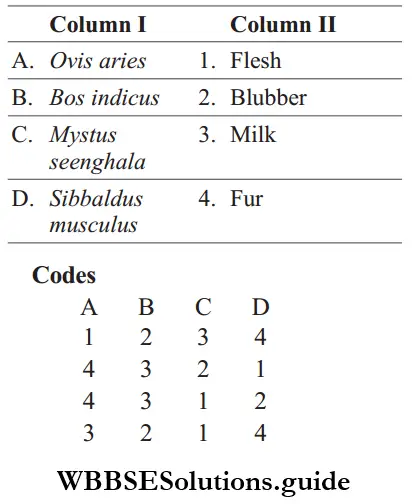
strategies for enhancement in food production pyq neet
Answer: A–4, B–3, C–1, D–2
Question 3. The remains of crops that are allowed to decay and decompose in the farmland is called
- Strip cropping
- Contour farming
- Mulching
- Terracing
Answer: 3. Mulching
- Mulching is a widely practised gardening technique that is beneficial for plants when done properly.
- It is the act of covering the soil with mulches such as bark, wood chips, leaves and other organic material in order to preserve moisture and improve the condition of the soil.
Biology MCQs with answers for NEET

NEET Biology strategies for enhancement in food production MCQs with answers
Question 4. Consider the following four statements (1-4) and select the option which includes the correct statements.
- Single-cell Spirulina can produce large quantities of food rich in protein, minerals, vitamins, etc.
- Body weight-wise, the microorganism Methylophilus methylotrophs may be able to produce several times more proteins than the cows per day.
- Common button mushrooms are a very rich source of vitamin- C.
- A rice variety has been developed which is very rich in calcium.
Choose the correct option.
- 3 and 4
- 1, 3 and 4
- 2, 3 and 4
- 1 and 2
Answer: 4. 1 and 2
- Statements 1 and 2 are correct.
- Spirulina is single cell rich in protein, vitamins and minerals.
- 250 biomass of Methylophilus methylotrophs produces 25 tonnes of protein/day, while cow of 250 kg produces only 200 g protein/day.
- Statements 3 and 4 are incorrect and can be corrected as
- Common button mushrooms are a very rich source of vitamin- D.
- A rice variety has been developed which is very rich in iron content.
Question 5. A drug to cure hypertension is derived from the roots of
- Atropa belladonna
- Femia asafoetida
- Rauwolfia serpentina
- Digitalis purpurea
Answer: 3. Rauwolfia serpentina
- Rauwolfia serpentina, the Indian snakeroot, devil pepper or serpentine wood, is a species of flower in the milkweed family- Apocynaceae.
- It is a compound commonly used in Ayurvedic medicines. Rauwolfia serpentina is a safe and effective treatment for hypertension.
Strategies for enhancement in food production multiple choice questions for NEET
Question 6. Pests which only feed and (oviposit) on crop are called
- Major pest
- Minor pest
- Accidental pest
- Occasional pest
Answer: 2. Minor pest
- Minor pests are the species that are recorded feeding or ovipositing on the crop plants.
- They usually inflict only slight damage on the host and often their effect on the plant is indiscernible.
Biology MCQs with answers for NEET
Question 7. Coffee is mainly produced in
- Tamil Nadu
- Andhra Pradesh
- Karnataka
- Kerala
Answer: 3. Karnataka
- Coffee production in India is dominated in the hill tracts of South
- Indian states with Karnataka accounting for 71%, followed by
- Kerala with 21% and Tamil Nadu (5% of overall production with 8,200 tonnes).
- Thus, coffee is mainly produced in Karnataka.
strategies for enhancement in food production pyq neet
Question 8. Match Column 1 with Column 2 and choose the correct option from the codes given below.
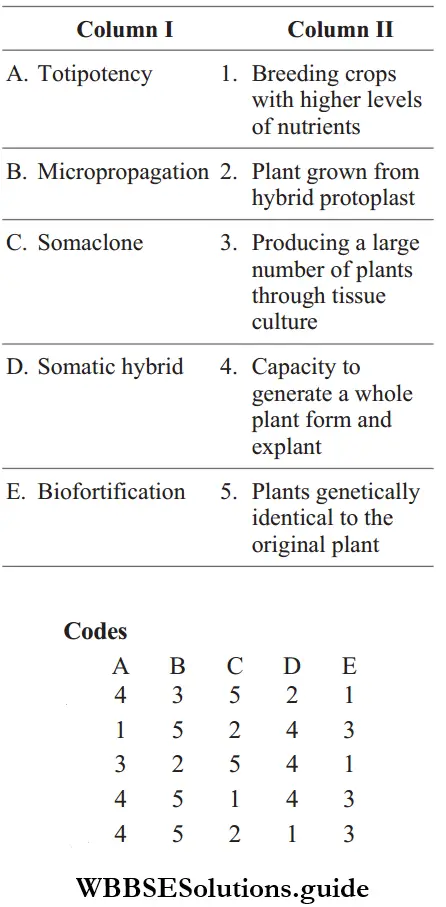
Answer: A–4, B–3, C–5, D–2, E–1
Important food production enhancement questions for NEET Biology
Question 9. Pasteurisation of milk involves heating for
- 60 minutes at about 90°C
- 30 minutes at about 50°C
- 30 minutes at about 60°C
- 60 minutes at 1000°C
Answer: 3. 30 minutes at about 60°C
Pasteurisation of milk is a method of partial sterilisation by heating the milk at 60-70°C for 30 min.
Question 10. Who is the first observed petroleum plant?
- Melvin Calvin
- Darwin
- Arnon
- R Hill
Answer: 1. Melvin Calvin
- Hydrocarbon plants are plants that follow certain metabolic pathways and produce hydrocarbon products similar to petroleum.
- The family– Euphorbiaceae has been studied in detail by Dr Melvin Calvin, Nobel Laureate and discoverer of the Calvin Cycle.
- So, he used the first observed petroleum plant.
Biology MCQs with answers for NEET
Question 11. Which wild plant is a good source of rubber?
- Parthenium argentatum
- Psophocarpus tetragonolobus
- Simmondsia chinensis
- Leucaena leucocephala
Answer: 1. Parthenium argentatum
Parthenium argentatum, commonly known as the guayule can be used as an alternative source of latex that is also hypoallergenic, unlike the normal Hevea rubber. So, It is a good source of rubber.
Question 12. Match the names of branches of biology listed under Column 1 with the fields of study given under Column 2.
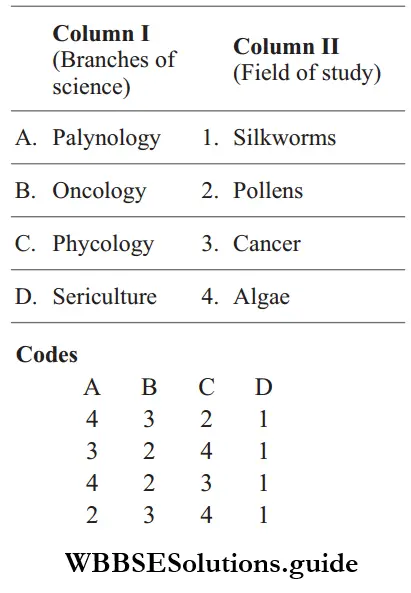
Answer: A–2, B–3, C–4, D–1
strategies for enhancement in food production pyq neet
Question 13. Match Column 1 in the pests with Column 2 in their most favoured host and choose the correct option from the codes given below.
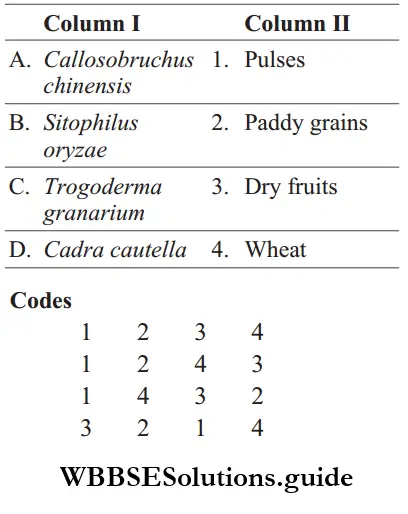
Answer: A–1, B–2, C–4, D–3
Solved MCQs on enhancement in food production for NEET
Question 14. The biggest drawback of draught animals is
- More consumption of bioenergy than production
- Short lifespan
- Early retirement
- Less reliability
Answer: 1. More consumption of bioenergy than production
A working animal or draught (draft) animal is domesticated and trained to perform tasks. Their biggest drawback is that they consume more bioenergy than they produce.
Biology MCQ For NEET With Answers
Question 15. The art and science of combining ideas, facilities, processes, materials and labour to produce and market a worthwhile product or service successfully is called
- Marketing
- Improvement
- Management
- Both 1 and 3
Answer: 3. Management
The art and science of combining, ideas, facilities, processes, materials and labour to produce and market a worthwhile product or service successfully called management.
Question 16. Assertion (A) The invasion of a part of the body of man or other animals by the eggs or larvae of flies is called myiasis. Reason (R) Musca domestica is known to oviposit in human tissues, so exhibit myiasis.
- Both A and R are true and R is the correct explanation of A
- Both A and R are true, but R is not the correct explanation of A
- A is true, but R is false
- Both A and R are false
Answer: 1. Both A and R are true and R is the correct explanation of A
Myiasis is the parasitic infestation of the body of a live animal by fly larvae (maggots) that grow inside the host while feeding on its tissue.
Role of plant breeding in food production NEET MCQs with answers
Question 17. The botanical name of Sanjeevani is
- Selaginella utricularia
- Selaginella biopterin
- Selaginella crotalaria
- None of the above
Answer: 2. Selaginella biopterin
- Selaginella biopterin (also called ‘Sanjeevani’or ‘Sanjivini booti’) is a lithophytic plant that is native to India.
- Traditional uses include relief from heat stroke, dysuria, irregular menstruation and jaundice, It is also useful for coma patients.
Question 18. Match the following columns.
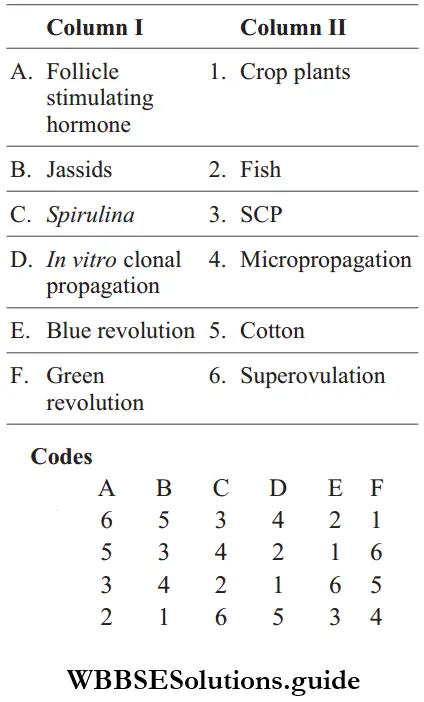
Answer: A–6, B–5, C–3, D–4, E–2, F–1
Best multiple choice questions on food production enhancement strategies for NEET preparation
Question 19. The female silkworm moth produces a chemical termed ‘Bombykol’. It is a
- Sex hormone
- An alarm pheromone
- Sex pheromone
- Juvenile hormone
Answer: 3. Sex pheromone
Bombykol is a pheromone released by the female silkworm moth to attract mates. It is also the sex pheromone in the wild silk moth (Bombyx mandarina).
strategies for enhancement in food production pyq neet
Question 20. They are called fixed oils as they are chemically esters of fatty acids synthesised by plants.
- Essential oils
- Vegetable oils
- Latex
- All of these
Answer: 2. Vegetable oils
- Fixed oils are pressed from the fatty portions of a plant or botanical, such as the seeds, nuts or kernels.
- They are also known as vegetable oils.
Biology MCQ For NEET With Answers
Question 21. Which of the following statements are correct?
- The maintenance of hives for the production of honey is called apiculture.
- A group of animals related by descent and similar in most characters is called a breed.
- The agriculture practice of breeding and raising livestock is called animal husbandry.
Choose the correct option.
- 1, 2 and 3
- 1 and 2
- 1 and 3
- 2 and 3
Answer: 1. 1, 2 and 3
All given statements are correct.
